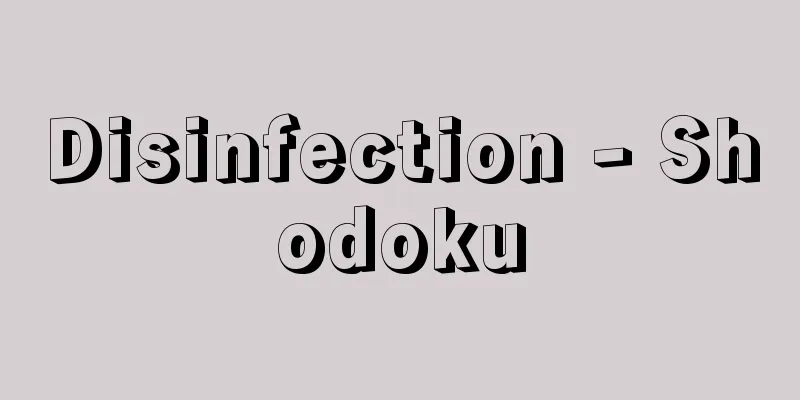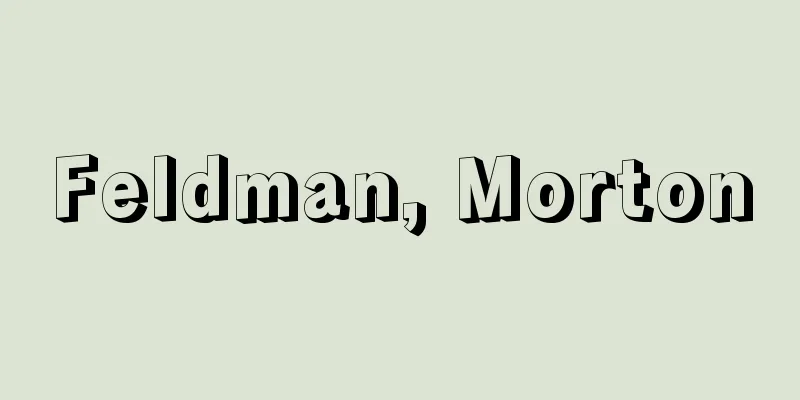Disinfection - Shodoku

|
Disinfection and sterilization are the most important basic techniques when dealing with microorganisms for medical treatment or research. Sterilization means killing the ability of all microorganisms to grow, regardless of whether they are pathogenic or non-pathogenic. Disinfection is used almost synonymously with sterilization, but the former is used for objects, whereas sterilization is usually used for the microorganisms themselves. For example, it is used to sterilize gauze or kill tuberculosis bacteria. Disinfection means killing microorganisms or inhibiting their growth to prevent food from decomposing and spoiling, and cleaning means removing pathogens or organic matter that is favorable for pathogens to survive or maintain their virulence from surfaces by washing or scrubbing with hot water, soap, or detergent, or by using a vacuum cleaner. Both are important in that they reduce the amount of infectious bacteria or keep it below the amount that causes disease. [Kasuga Hitoshi] Physical disinfectionHeat is the most commonly used method, but ultraviolet light and radiation (gamma rays) are also used. Filtration is effective in removing microorganisms, and is used to provide safe water and air. [1] Heat (1) Incineration. Used for human and animal corpses, as well as paper and cloth. (2) Dry heat sterilization. Usually used for glass items such as laboratory and medical equipment, it can be sterilized at 160-180°C for 1-2 hours. (3) Boiling. Used most often for tableware, small pieces of cloth, etc., it can sterilize most microorganisms except for spores at 100°C for 15 minutes. (4) High-pressure steam sterilization. Steam sterilization is performed at 1 atmosphere and high temperature (121°C), which also kills spores. It is widely used in hospitals as a reliable and safe sterilization method, but is not suitable for sterilizing items that deteriorate at high temperatures or powders and oils. [2] Ultraviolet rays and radiation The germicidal effect of sunlight disinfection of bedding, books, etc. is due to ultraviolet rays, which is effective against most microorganisms present in the air or on surfaces, but the radiation dose weakens inversely proportional to the square of the distance, and is ineffective in shaded areas. In Japan, irradiation of some foods has been permitted since 1972. [3] Filtration method: Uses fiber filters with high filtration efficiency. With the development of products, it has become possible to filter almost all airborne microorganisms, and these filters are used in exhaust systems for hospital rooms and operating rooms, as well as in various sterilization rooms. [Kasuga Hitoshi] Chemical disinfection methodsSterilization is carried out using so-called disinfectants, of which there are many available, including surfactants, halogens and their compounds, alcohols, and gaseous chemicals. [1] Cresol soapy water: It is used against normal bacteria, but is ineffective against spores and viruses. [2] Surfactants There are cationic soaps and amphoteric surfactants, but both are ineffective against spores, and their effectiveness against viruses varies depending on the type. [3] Halogen-based disinfectants These include chlorine-based disinfectants such as bleaching powder and sodium hypochlorite, and mixtures of iodine and surfactants. Chlorine-based disinfectants, which use free chlorine, are effective against bacteria, spores, and viruses, but are less effective against tuberculosis bacteria. Iodine-based disinfectants are said to be effective against almost all microorganisms. [4] Alcohols There are ethanol (ethyl alcohol) and isopropanol (isopropyl alcohol), and ethanol is used in a 70% solution. It is effective against almost all bacteria, viruses, and rickettsia, including tuberculosis bacteria, but is ineffective against spores. [5] Those that act in gas form Formaldehyde and ethylene oxide are used. Formaldehyde gas is obtained by heating formalin water or adding potassium permanganate to formalin water, and is used for fumigating hospital rooms. Ethylene oxide gas has a low boiling point, so it can act at relatively low temperatures and dissipates quickly. It has a stronger bactericidal effect than the former, making it suitable for sterilizing items that are sensitive to heat and moisture. Both are effective against the majority of microorganisms, including spores, viruses, and tuberculosis bacteria, and have been used extensively in recent years. [6] Others Lime (lime milk, caustic lime, etc.) is very cheap and easy to obtain, so it is used to disinfect outdoor areas such as waterways, gutters, septic tanks, and buildings. A 5% aqueous solution of chlorine lime is used to disinfect wells, etc. In the past, legal disinfectants and alternative disinfectants were specified in the Enforcement Regulations of the Infectious Diseases Prevention Law. However, with the abolition of the Infectious Diseases Prevention Law in 1999, the distinction between these drugs was abolished, and instead the Ministry of Health, Labor and Welfare has issued guidelines for the use of drugs. Needless to say, the most appropriate method must be selected depending on the type of object and pathogenic microorganism in question. Disinfection during an infectious disease outbreak can be divided into "immediate disinfection," in which contaminated material discharged from an infected person and any objects that have come into contact with it are disinfected as quickly as possible, and "terminal disinfection," in which items used by the patient and the hospital room are disinfected after the patient has died or is no longer a source of infection. [Kasuga Hitoshi] [Reference item] |Source: Shogakukan Encyclopedia Nipponica About Encyclopedia Nipponica Information | Legend |
|
病原体を身体の外部で理学的あるいは化学的手段で直接に殺すことをいい、医療や研究のため、微生物を扱う場合、消毒と滅菌はもっともたいせつな基本的技術である。なお「滅菌」とは、病原体・非病原体を問わず、すべての微生物の増殖能力を死滅させることをいい、「殺菌」もほぼ滅菌と同義語に用いられるが、前者が物品を対象として用いられるのに対し、「殺菌」では微生物自体を直接の対象とするのが普通である。たとえば、ガーゼの滅菌、結核菌の殺菌というように用いられる。また「消毒」とは、微生物を死滅させるか、その発育を阻止して食物の分解腐敗を防ぐことであり、「清浄(クリーニング)」とは、病原体、あるいは病原体が生存したり毒力を保つために有利な有機物を、熱湯、せっけん、洗剤で洗ったり、こすったりするか、真空掃除器で表面から除去することであり、いずれも感染菌量を減少させ、あるいはそれを発病量以下に抑える点で重要な意義をもつ。 [春日 齊] 理学的消毒法熱がもっとも多く用いられ、紫外線、放射線(γ(ガンマ)線)も応用される。濾過(ろか)法は微生物除去に有効であり、安全な水、空気の供給に用いられる。 〔1〕熱 (1)焼却処理。ヒトおよび動物の死体のほか、紙や布などに用いる。(2)乾熱滅菌法。通常は実験器具・医療器具などガラス類に用いられ、160~180℃・1~2時間で滅菌できる。(3)煮沸消毒。食器、小形の布など、日常もっとも用いられるもので、100℃・15分間で芽胞を除くほとんどの微生物を殺菌できる。(4)高圧蒸気滅菌法。1気圧・高温(121℃)で蒸気滅菌を行うもので、芽胞も死滅させる。確実・安全な滅菌法として、病院などで広く用いられているが、高温で変質するものや、粉末、油などの滅菌には不適である。 〔2〕紫外線・放射線 寝具、書物などの日光消毒の殺菌効果は紫外線によるものであって、空中や表面に存在するほとんどの微生物に対して有効であるが、線量は距離の2乗に反比例して弱くなり、影の部分では無効となる。なお、日本では1972年(昭和47)から一部の食品の放射線照射が認められている。 〔3〕濾過法 濾過効率の高い繊維フィルターを利用する。製品の発達によって、ほとんどすべての浮遊微生物が濾過できるようになり、病室、手術室の排気や各種滅菌室に利用されている。 [春日 齊] 化学的消毒法いわゆる消毒薬を用いて殺菌するもので、界面活性剤、ハロゲンおよびその化合物、アルコール類、ガス状で作用する薬品など多くのものがある。 〔1〕クレゾールせっけん水 通常の細菌に用いられるが、芽胞やウイルスには無効である。 〔2〕界面活性剤 逆性せっけんと両性界面活性剤があるが、両者とも芽胞には無効で、ウイルスに対しても種類によって効果が一定していない。 〔3〕ハロゲン系消毒薬 さらし粉、次亜塩素酸ナトリウムなどの塩素系と、ヨウ素と界面活性剤などの混合物がある。遊離塩素で殺菌する塩素系は、細菌や芽胞、ウイルスには有効であるが、結核菌には効果が少ない。ヨウ素系は、ほとんどすべての微生物に有効とされる。 〔4〕アルコール類 エタノール(エチルアルコール)とイソプロパノール(イソプロピルアルコール)があり、エタノールは70%溶液が用いられる。結核菌をはじめ、ほとんどすべての細菌、ウイルス、リケッチアに有効であるが、芽胞には無効である。 〔5〕ガス状で作用するもの ホルムアルデヒドとエチレンオキシドが用いられる。ホルムアルデヒド・ガスは、ホルマリン水を加熱したり、ホルマリン水に過マンガン酸カリウムを投入して得られるもので、病室の燻蒸(くんじょう)などに利用される。エチレンオキシド・ガスは、沸点が低いため、比較的低温で作用させることができ、ガスの発散も早い。殺菌効果も前者より強いため、熱や湿気などに弱い物品の滅菌に適している。両者とも芽胞、ウイルス、結核菌を含めた大多数の微生物に有効で、近年はとくに多用されている。 〔6〕その他 石灰(石灰乳・煆製(かせい)石灰など)はきわめて安価で入手が容易なため、水路、どぶ、便池、建物など屋外の消毒に用いられる。クロル石灰の5%水溶液は井戸などの消毒に利用される。 なお、かつては、伝染病予防法施行規則で法定消毒薬品および代用消毒薬品が指定されていたが、1999年(平成11)の伝染病予防法廃止に伴い、これら薬品の区別はなくなり、かわって厚生労働省から薬品使用のガイドラインが示されている。 以上の方法は、対象とする物や病原微生物の種類によって適切なものを選ぶ必要があることはいうまでもない。なお、伝染病発生時の消毒は、感染者から排出される汚染物や、それと接触した器物をできるだけ速やかに消毒する「即時消毒」と、患者が死亡したり感染源でなくなったりしたあと、患者の使用した物品や病室などを消毒する「終末消毒」とに分けられる。 [春日 齊] [参照項目] |出典 小学館 日本大百科全書(ニッポニカ)日本大百科全書(ニッポニカ)について 情報 | 凡例 |
Recommend
Gold rice cake - Kinpei
…On the other hand, in the southern territory of ...
Visconti, U. (English spelling) ViscontiU
…In the first half of the 13th century, the famil...
Saburo Shimada
A journalist and politician during the Meiji and ...
National Diet - Kokai
It is a bicameral parliament consisting of the Ho...
Brodie abscess (English spelling) Brodie abscess
…In this method, after sufficient removal of the ...
Queue - bian-fa; pien-fa
Also called chihatsu. A hairstyle unique to men th...
Goyu - Goyu
A post station that has existed since the Middle A...
Spring Breeze Horse Bank Song - Shunpuubatei no Kyoku
This is a haiku poem by Buson. It was published a...
Main dormitory - Tonomori
A ritsuryo government office belonging to the Impe...
Turkish bath - Torukoburo (English name) Turkish bath
A dry bath is a closed room filled with hot air, ...
Autobrecciated lava
The broken parts of lava flow that occur during it...
Administrative excavation survey - administrative excavation survey
… [Current situation and issues] Excavations are ...
Tansy (English spelling)
A genus of the Asteraceae family consisting of abo...
Ishisankokyo - The Three Great Mirrors
...The Panlong mirror depicts a dragon lurking wi...
Galapagos Ridge
The chemical synthesis of sulfur bacteria is the ...









